Challenges Faced by Nurses in Delivering Care Services
VerifiedAdded on 2023/04/21
|11
|2392
|217
AI Summary
This article discusses the challenges that nurses face in delivering care services, including understaffing, workplace violence, and workplace hazards. It also explores the Institute of Medicine (IOM) second Core Message and IOM five core competencies for nursing practice.
Contribute Materials
Your contribution can guide someone’s learning journey. Share your
documents today.
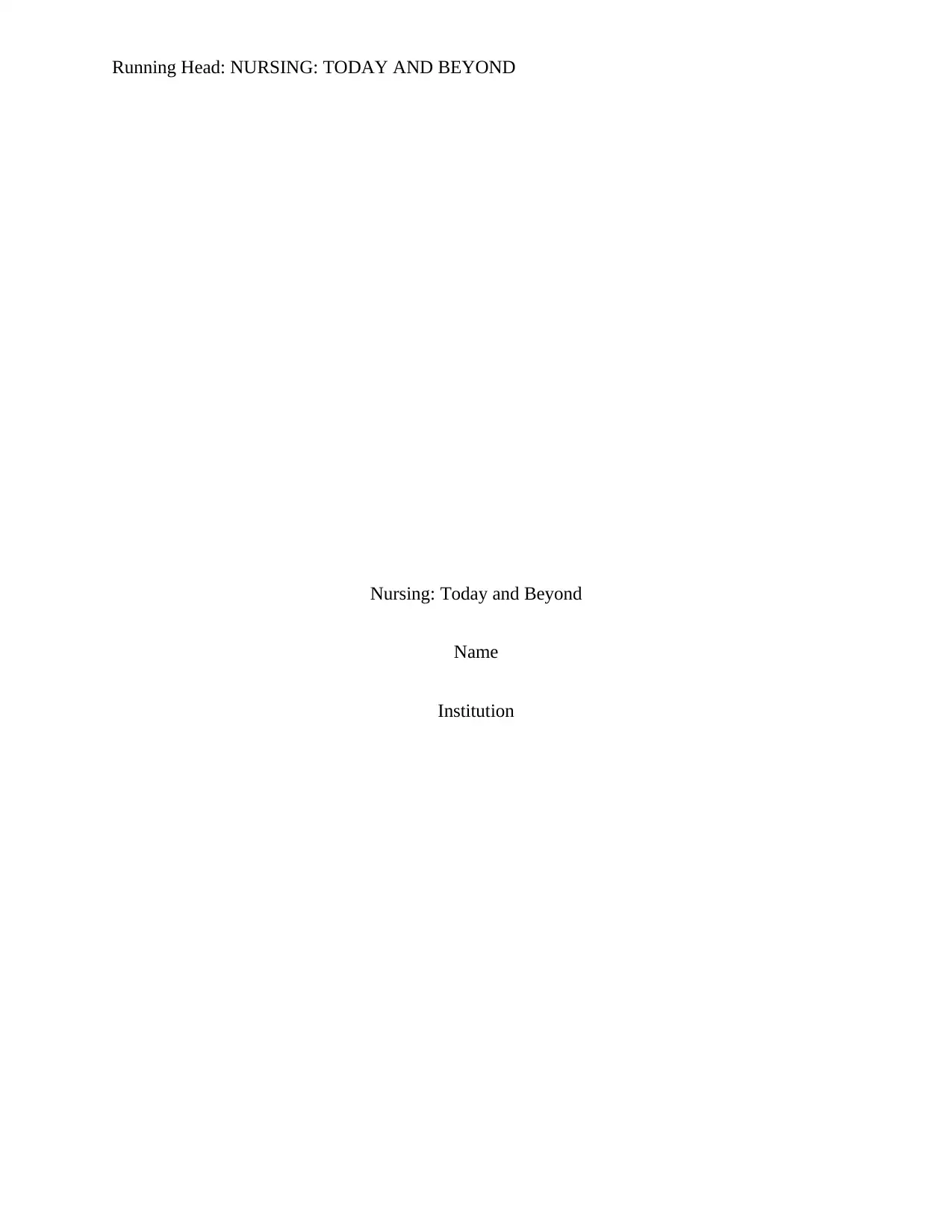
Running Head: NURSING: TODAY AND BEYOND
Nursing: Today and Beyond
Name
Institution
Nursing: Today and Beyond
Name
Institution
Secure Best Marks with AI Grader
Need help grading? Try our AI Grader for instant feedback on your assignments.
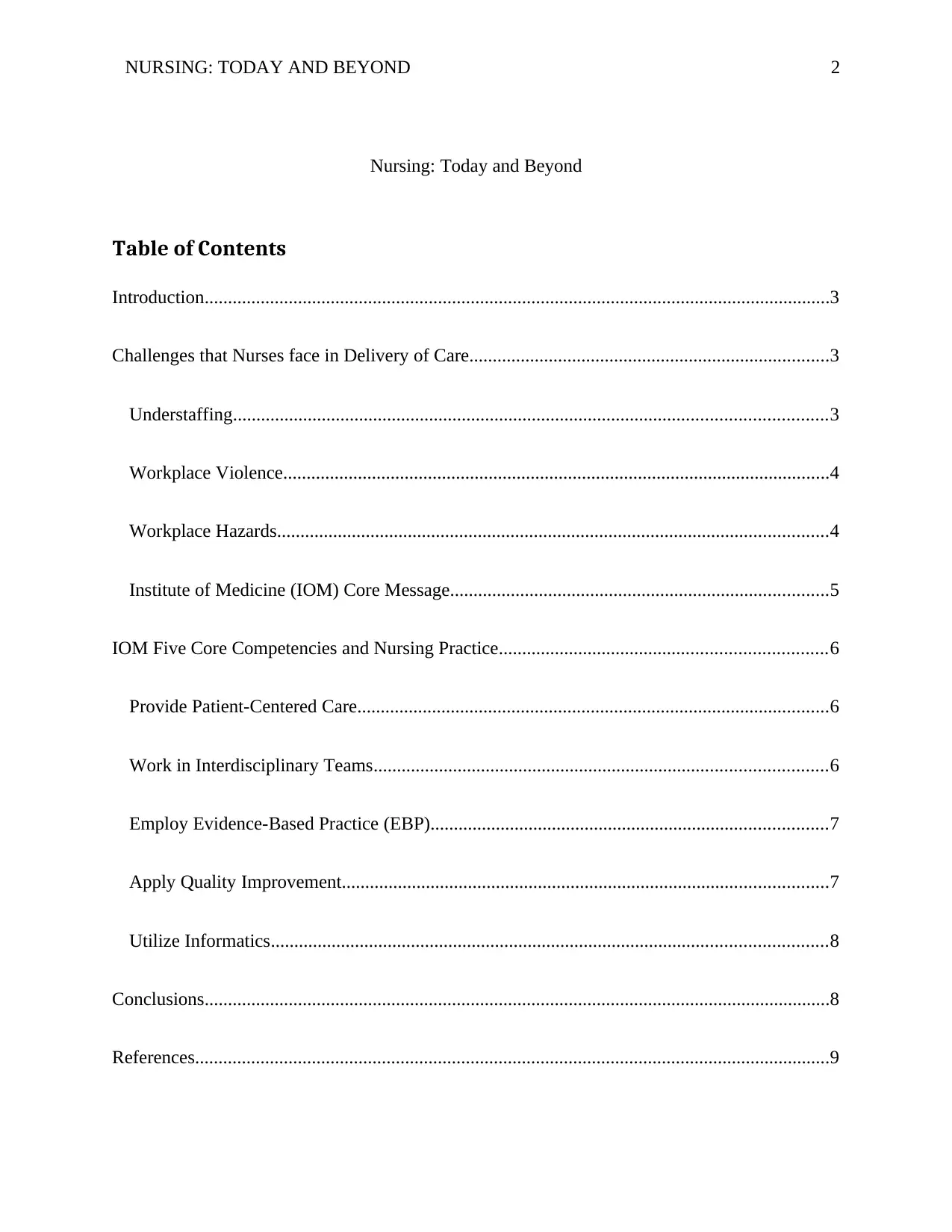
NURSING: TODAY AND BEYOND 2
Nursing: Today and Beyond
Table of Contents
Introduction......................................................................................................................................3
Challenges that Nurses face in Delivery of Care.............................................................................3
Understaffing...............................................................................................................................3
Workplace Violence.....................................................................................................................4
Workplace Hazards......................................................................................................................4
Institute of Medicine (IOM) Core Message.................................................................................5
IOM Five Core Competencies and Nursing Practice......................................................................6
Provide Patient-Centered Care.....................................................................................................6
Work in Interdisciplinary Teams.................................................................................................6
Employ Evidence-Based Practice (EBP).....................................................................................7
Apply Quality Improvement........................................................................................................7
Utilize Informatics.......................................................................................................................8
Conclusions......................................................................................................................................8
References........................................................................................................................................9
Nursing: Today and Beyond
Table of Contents
Introduction......................................................................................................................................3
Challenges that Nurses face in Delivery of Care.............................................................................3
Understaffing...............................................................................................................................3
Workplace Violence.....................................................................................................................4
Workplace Hazards......................................................................................................................4
Institute of Medicine (IOM) Core Message.................................................................................5
IOM Five Core Competencies and Nursing Practice......................................................................6
Provide Patient-Centered Care.....................................................................................................6
Work in Interdisciplinary Teams.................................................................................................6
Employ Evidence-Based Practice (EBP).....................................................................................7
Apply Quality Improvement........................................................................................................7
Utilize Informatics.......................................................................................................................8
Conclusions......................................................................................................................................8
References........................................................................................................................................9
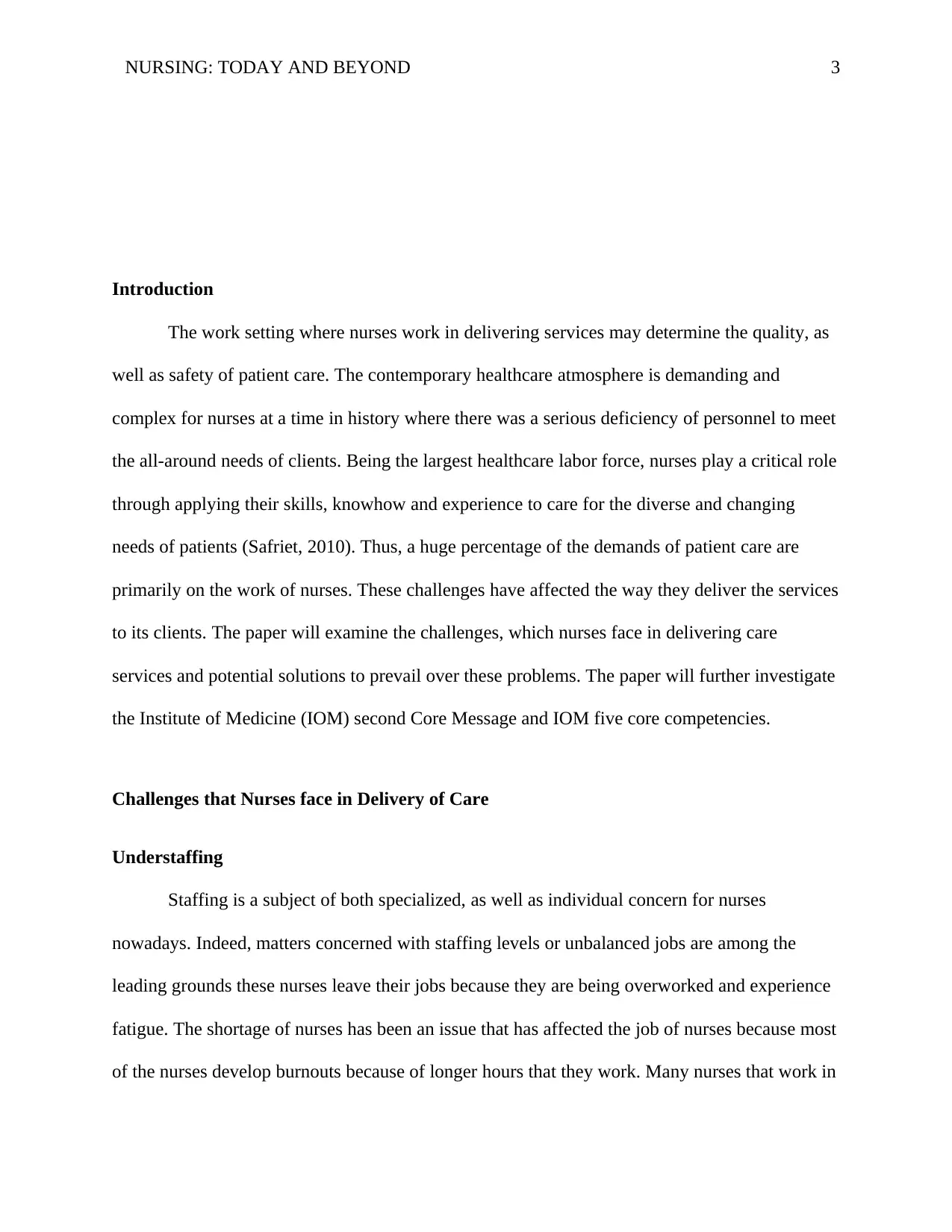
NURSING: TODAY AND BEYOND 3
Introduction
The work setting where nurses work in delivering services may determine the quality, as
well as safety of patient care. The contemporary healthcare atmosphere is demanding and
complex for nurses at a time in history where there was a serious deficiency of personnel to meet
the all-around needs of clients. Being the largest healthcare labor force, nurses play a critical role
through applying their skills, knowhow and experience to care for the diverse and changing
needs of patients (Safriet, 2010). Thus, a huge percentage of the demands of patient care are
primarily on the work of nurses. These challenges have affected the way they deliver the services
to its clients. The paper will examine the challenges, which nurses face in delivering care
services and potential solutions to prevail over these problems. The paper will further investigate
the Institute of Medicine (IOM) second Core Message and IOM five core competencies.
Challenges that Nurses face in Delivery of Care
Understaffing
Staffing is a subject of both specialized, as well as individual concern for nurses
nowadays. Indeed, matters concerned with staffing levels or unbalanced jobs are among the
leading grounds these nurses leave their jobs because they are being overworked and experience
fatigue. The shortage of nurses has been an issue that has affected the job of nurses because most
of the nurses develop burnouts because of longer hours that they work. Many nurses that work in
Introduction
The work setting where nurses work in delivering services may determine the quality, as
well as safety of patient care. The contemporary healthcare atmosphere is demanding and
complex for nurses at a time in history where there was a serious deficiency of personnel to meet
the all-around needs of clients. Being the largest healthcare labor force, nurses play a critical role
through applying their skills, knowhow and experience to care for the diverse and changing
needs of patients (Safriet, 2010). Thus, a huge percentage of the demands of patient care are
primarily on the work of nurses. These challenges have affected the way they deliver the services
to its clients. The paper will examine the challenges, which nurses face in delivering care
services and potential solutions to prevail over these problems. The paper will further investigate
the Institute of Medicine (IOM) second Core Message and IOM five core competencies.
Challenges that Nurses face in Delivery of Care
Understaffing
Staffing is a subject of both specialized, as well as individual concern for nurses
nowadays. Indeed, matters concerned with staffing levels or unbalanced jobs are among the
leading grounds these nurses leave their jobs because they are being overworked and experience
fatigue. The shortage of nurses has been an issue that has affected the job of nurses because most
of the nurses develop burnouts because of longer hours that they work. Many nurses that work in
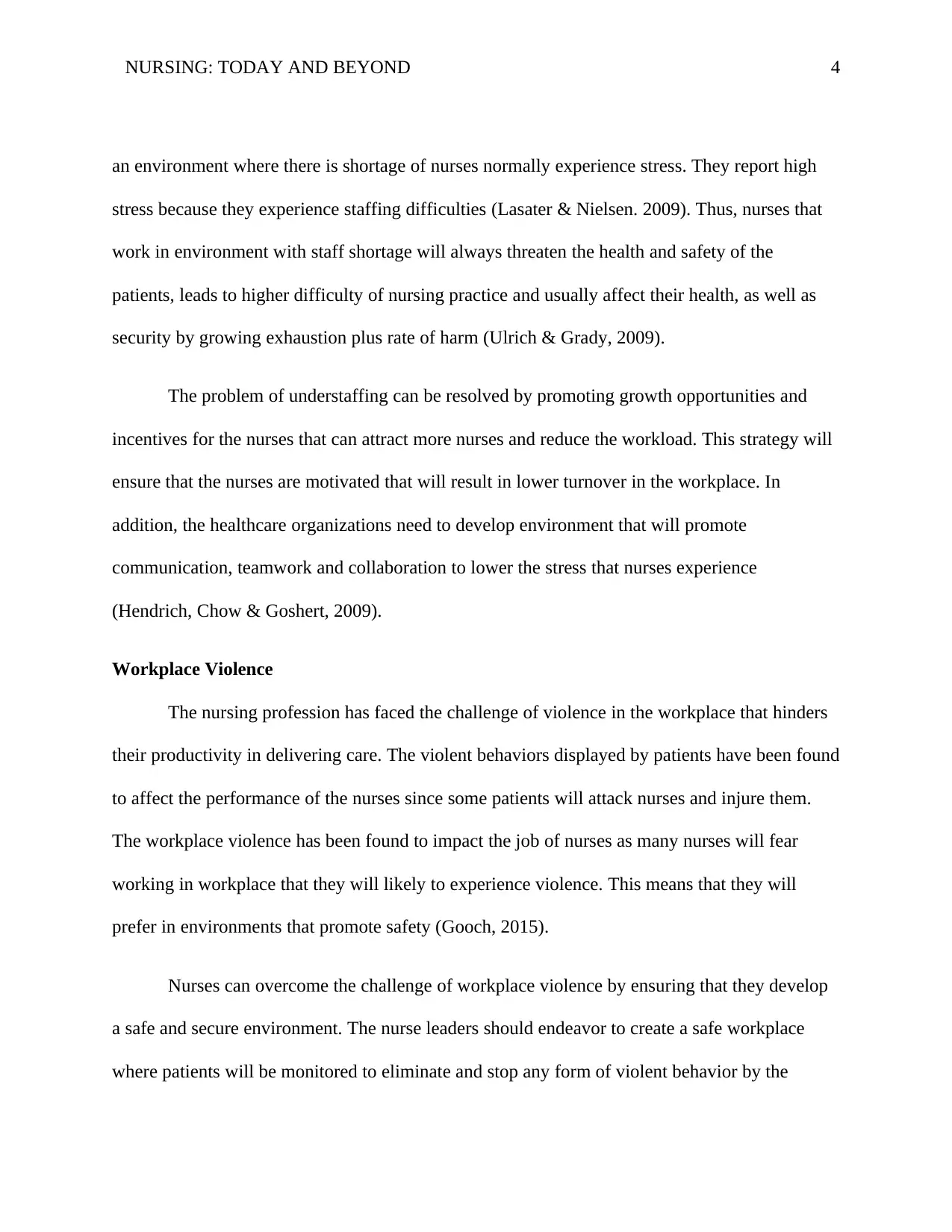
NURSING: TODAY AND BEYOND 4
an environment where there is shortage of nurses normally experience stress. They report high
stress because they experience staffing difficulties (Lasater & Nielsen. 2009). Thus, nurses that
work in environment with staff shortage will always threaten the health and safety of the
patients, leads to higher difficulty of nursing practice and usually affect their health, as well as
security by growing exhaustion plus rate of harm (Ulrich & Grady, 2009).
The problem of understaffing can be resolved by promoting growth opportunities and
incentives for the nurses that can attract more nurses and reduce the workload. This strategy will
ensure that the nurses are motivated that will result in lower turnover in the workplace. In
addition, the healthcare organizations need to develop environment that will promote
communication, teamwork and collaboration to lower the stress that nurses experience
(Hendrich, Chow & Goshert, 2009).
Workplace Violence
The nursing profession has faced the challenge of violence in the workplace that hinders
their productivity in delivering care. The violent behaviors displayed by patients have been found
to affect the performance of the nurses since some patients will attack nurses and injure them.
The workplace violence has been found to impact the job of nurses as many nurses will fear
working in workplace that they will likely to experience violence. This means that they will
prefer in environments that promote safety (Gooch, 2015).
Nurses can overcome the challenge of workplace violence by ensuring that they develop
a safe and secure environment. The nurse leaders should endeavor to create a safe workplace
where patients will be monitored to eliminate and stop any form of violent behavior by the
an environment where there is shortage of nurses normally experience stress. They report high
stress because they experience staffing difficulties (Lasater & Nielsen. 2009). Thus, nurses that
work in environment with staff shortage will always threaten the health and safety of the
patients, leads to higher difficulty of nursing practice and usually affect their health, as well as
security by growing exhaustion plus rate of harm (Ulrich & Grady, 2009).
The problem of understaffing can be resolved by promoting growth opportunities and
incentives for the nurses that can attract more nurses and reduce the workload. This strategy will
ensure that the nurses are motivated that will result in lower turnover in the workplace. In
addition, the healthcare organizations need to develop environment that will promote
communication, teamwork and collaboration to lower the stress that nurses experience
(Hendrich, Chow & Goshert, 2009).
Workplace Violence
The nursing profession has faced the challenge of violence in the workplace that hinders
their productivity in delivering care. The violent behaviors displayed by patients have been found
to affect the performance of the nurses since some patients will attack nurses and injure them.
The workplace violence has been found to impact the job of nurses as many nurses will fear
working in workplace that they will likely to experience violence. This means that they will
prefer in environments that promote safety (Gooch, 2015).
Nurses can overcome the challenge of workplace violence by ensuring that they develop
a safe and secure environment. The nurse leaders should endeavor to create a safe workplace
where patients will be monitored to eliminate and stop any form of violent behavior by the
Secure Best Marks with AI Grader
Need help grading? Try our AI Grader for instant feedback on your assignments.
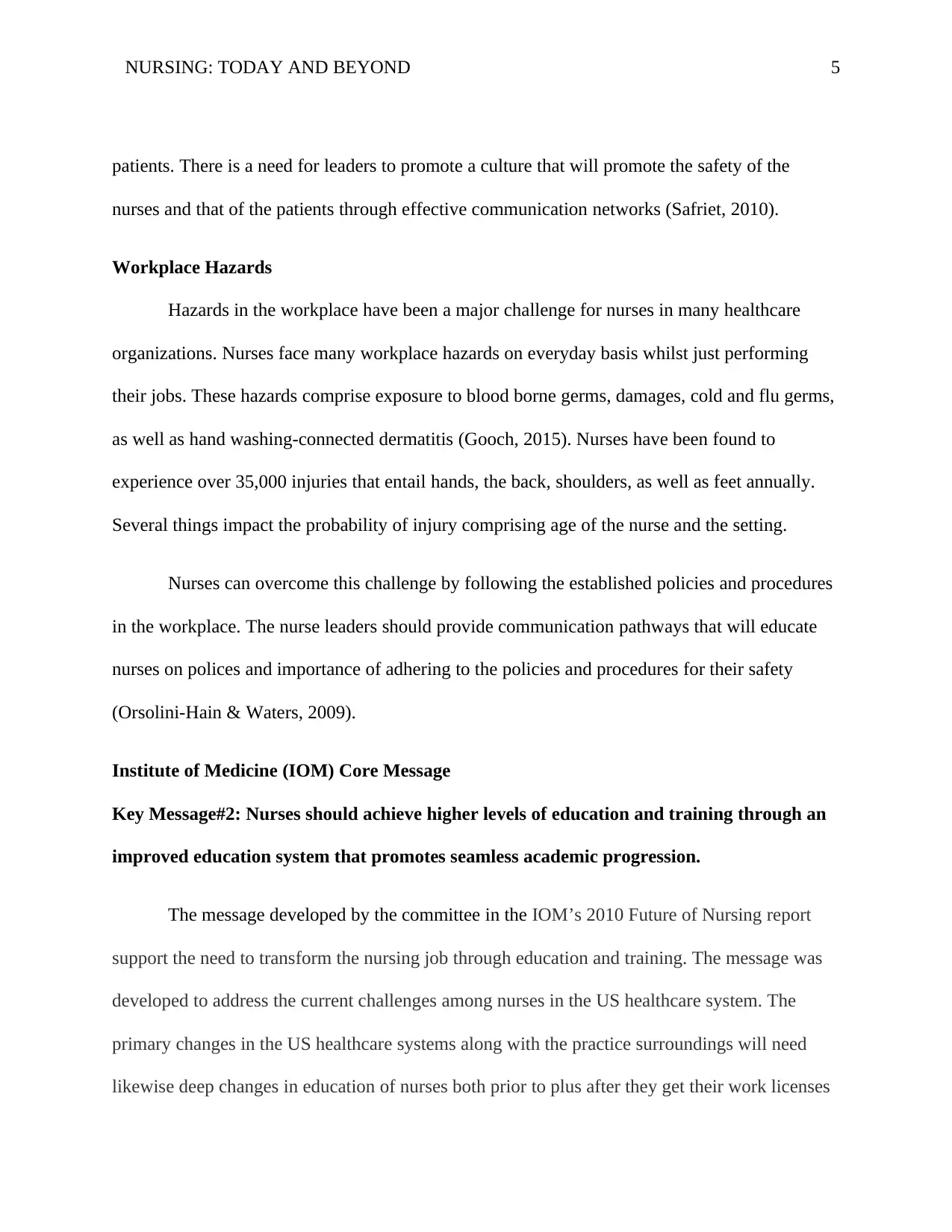
NURSING: TODAY AND BEYOND 5
patients. There is a need for leaders to promote a culture that will promote the safety of the
nurses and that of the patients through effective communication networks (Safriet, 2010).
Workplace Hazards
Hazards in the workplace have been a major challenge for nurses in many healthcare
organizations. Nurses face many workplace hazards on everyday basis whilst just performing
their jobs. These hazards comprise exposure to blood borne germs, damages, cold and flu germs,
as well as hand washing-connected dermatitis (Gooch, 2015). Nurses have been found to
experience over 35,000 injuries that entail hands, the back, shoulders, as well as feet annually.
Several things impact the probability of injury comprising age of the nurse and the setting.
Nurses can overcome this challenge by following the established policies and procedures
in the workplace. The nurse leaders should provide communication pathways that will educate
nurses on polices and importance of adhering to the policies and procedures for their safety
(Orsolini-Hain & Waters, 2009).
Institute of Medicine (IOM) Core Message
Key Message#2: Nurses should achieve higher levels of education and training through an
improved education system that promotes seamless academic progression.
The message developed by the committee in the IOM’s 2010 Future of Nursing report
support the need to transform the nursing job through education and training. The message was
developed to address the current challenges among nurses in the US healthcare system. The
primary changes in the US healthcare systems along with the practice surroundings will need
likewise deep changes in education of nurses both prior to plus after they get their work licenses
patients. There is a need for leaders to promote a culture that will promote the safety of the
nurses and that of the patients through effective communication networks (Safriet, 2010).
Workplace Hazards
Hazards in the workplace have been a major challenge for nurses in many healthcare
organizations. Nurses face many workplace hazards on everyday basis whilst just performing
their jobs. These hazards comprise exposure to blood borne germs, damages, cold and flu germs,
as well as hand washing-connected dermatitis (Gooch, 2015). Nurses have been found to
experience over 35,000 injuries that entail hands, the back, shoulders, as well as feet annually.
Several things impact the probability of injury comprising age of the nurse and the setting.
Nurses can overcome this challenge by following the established policies and procedures
in the workplace. The nurse leaders should provide communication pathways that will educate
nurses on polices and importance of adhering to the policies and procedures for their safety
(Orsolini-Hain & Waters, 2009).
Institute of Medicine (IOM) Core Message
Key Message#2: Nurses should achieve higher levels of education and training through an
improved education system that promotes seamless academic progression.
The message developed by the committee in the IOM’s 2010 Future of Nursing report
support the need to transform the nursing job through education and training. The message was
developed to address the current challenges among nurses in the US healthcare system. The
primary changes in the US healthcare systems along with the practice surroundings will need
likewise deep changes in education of nurses both prior to plus after they get their work licenses
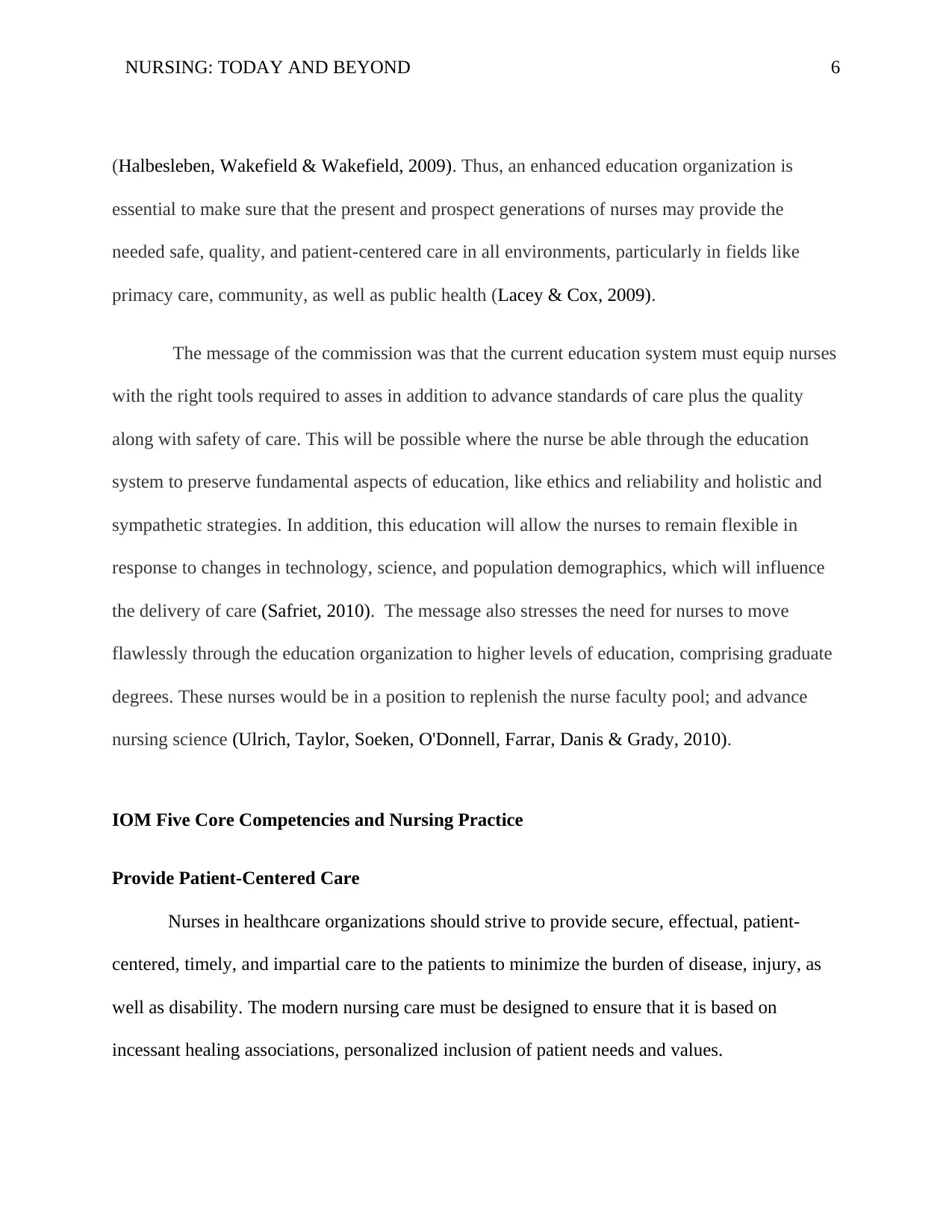
NURSING: TODAY AND BEYOND 6
(Halbesleben, Wakefield & Wakefield, 2009). Thus, an enhanced education organization is
essential to make sure that the present and prospect generations of nurses may provide the
needed safe, quality, and patient-centered care in all environments, particularly in fields like
primacy care, community, as well as public health (Lacey & Cox, 2009).
The message of the commission was that the current education system must equip nurses
with the right tools required to asses in addition to advance standards of care plus the quality
along with safety of care. This will be possible where the nurse be able through the education
system to preserve fundamental aspects of education, like ethics and reliability and holistic and
sympathetic strategies. In addition, this education will allow the nurses to remain flexible in
response to changes in technology, science, and population demographics, which will influence
the delivery of care (Safriet, 2010). The message also stresses the need for nurses to move
flawlessly through the education organization to higher levels of education, comprising graduate
degrees. These nurses would be in a position to replenish the nurse faculty pool; and advance
nursing science (Ulrich, Taylor, Soeken, O'Donnell, Farrar, Danis & Grady, 2010).
IOM Five Core Competencies and Nursing Practice
Provide Patient-Centered Care
Nurses in healthcare organizations should strive to provide secure, effectual, patient-
centered, timely, and impartial care to the patients to minimize the burden of disease, injury, as
well as disability. The modern nursing care must be designed to ensure that it is based on
incessant healing associations, personalized inclusion of patient needs and values.
(Halbesleben, Wakefield & Wakefield, 2009). Thus, an enhanced education organization is
essential to make sure that the present and prospect generations of nurses may provide the
needed safe, quality, and patient-centered care in all environments, particularly in fields like
primacy care, community, as well as public health (Lacey & Cox, 2009).
The message of the commission was that the current education system must equip nurses
with the right tools required to asses in addition to advance standards of care plus the quality
along with safety of care. This will be possible where the nurse be able through the education
system to preserve fundamental aspects of education, like ethics and reliability and holistic and
sympathetic strategies. In addition, this education will allow the nurses to remain flexible in
response to changes in technology, science, and population demographics, which will influence
the delivery of care (Safriet, 2010). The message also stresses the need for nurses to move
flawlessly through the education organization to higher levels of education, comprising graduate
degrees. These nurses would be in a position to replenish the nurse faculty pool; and advance
nursing science (Ulrich, Taylor, Soeken, O'Donnell, Farrar, Danis & Grady, 2010).
IOM Five Core Competencies and Nursing Practice
Provide Patient-Centered Care
Nurses in healthcare organizations should strive to provide secure, effectual, patient-
centered, timely, and impartial care to the patients to minimize the burden of disease, injury, as
well as disability. The modern nursing care must be designed to ensure that it is based on
incessant healing associations, personalized inclusion of patient needs and values.
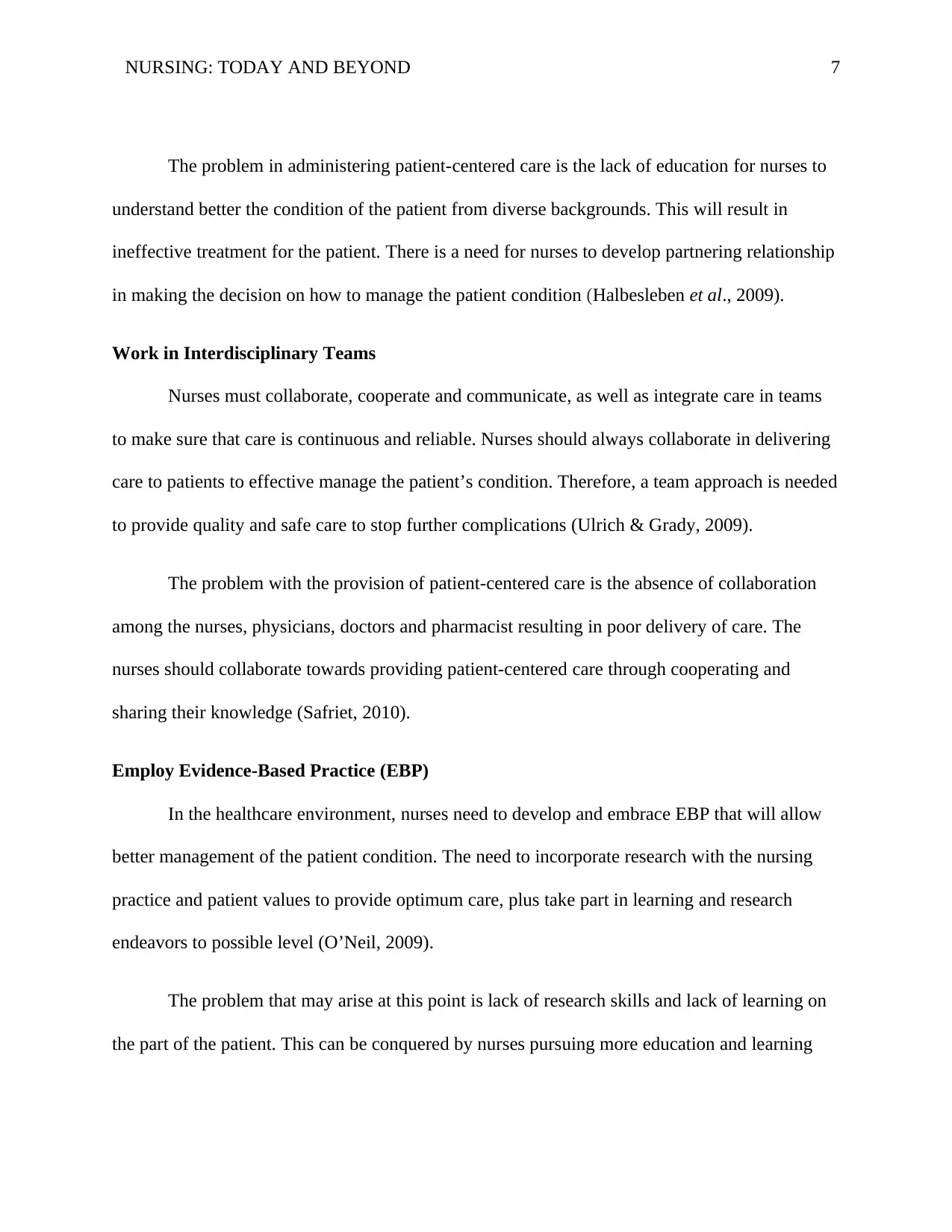
NURSING: TODAY AND BEYOND 7
The problem in administering patient-centered care is the lack of education for nurses to
understand better the condition of the patient from diverse backgrounds. This will result in
ineffective treatment for the patient. There is a need for nurses to develop partnering relationship
in making the decision on how to manage the patient condition (Halbesleben et al., 2009).
Work in Interdisciplinary Teams
Nurses must collaborate, cooperate and communicate, as well as integrate care in teams
to make sure that care is continuous and reliable. Nurses should always collaborate in delivering
care to patients to effective manage the patient’s condition. Therefore, a team approach is needed
to provide quality and safe care to stop further complications (Ulrich & Grady, 2009).
The problem with the provision of patient-centered care is the absence of collaboration
among the nurses, physicians, doctors and pharmacist resulting in poor delivery of care. The
nurses should collaborate towards providing patient-centered care through cooperating and
sharing their knowledge (Safriet, 2010).
Employ Evidence-Based Practice (EBP)
In the healthcare environment, nurses need to develop and embrace EBP that will allow
better management of the patient condition. The need to incorporate research with the nursing
practice and patient values to provide optimum care, plus take part in learning and research
endeavors to possible level (O’Neil, 2009).
The problem that may arise at this point is lack of research skills and lack of learning on
the part of the patient. This can be conquered by nurses pursuing more education and learning
The problem in administering patient-centered care is the lack of education for nurses to
understand better the condition of the patient from diverse backgrounds. This will result in
ineffective treatment for the patient. There is a need for nurses to develop partnering relationship
in making the decision on how to manage the patient condition (Halbesleben et al., 2009).
Work in Interdisciplinary Teams
Nurses must collaborate, cooperate and communicate, as well as integrate care in teams
to make sure that care is continuous and reliable. Nurses should always collaborate in delivering
care to patients to effective manage the patient’s condition. Therefore, a team approach is needed
to provide quality and safe care to stop further complications (Ulrich & Grady, 2009).
The problem with the provision of patient-centered care is the absence of collaboration
among the nurses, physicians, doctors and pharmacist resulting in poor delivery of care. The
nurses should collaborate towards providing patient-centered care through cooperating and
sharing their knowledge (Safriet, 2010).
Employ Evidence-Based Practice (EBP)
In the healthcare environment, nurses need to develop and embrace EBP that will allow
better management of the patient condition. The need to incorporate research with the nursing
practice and patient values to provide optimum care, plus take part in learning and research
endeavors to possible level (O’Neil, 2009).
The problem that may arise at this point is lack of research skills and lack of learning on
the part of the patient. This can be conquered by nurses pursuing more education and learning
Paraphrase This Document
Need a fresh take? Get an instant paraphrase of this document with our AI Paraphraser
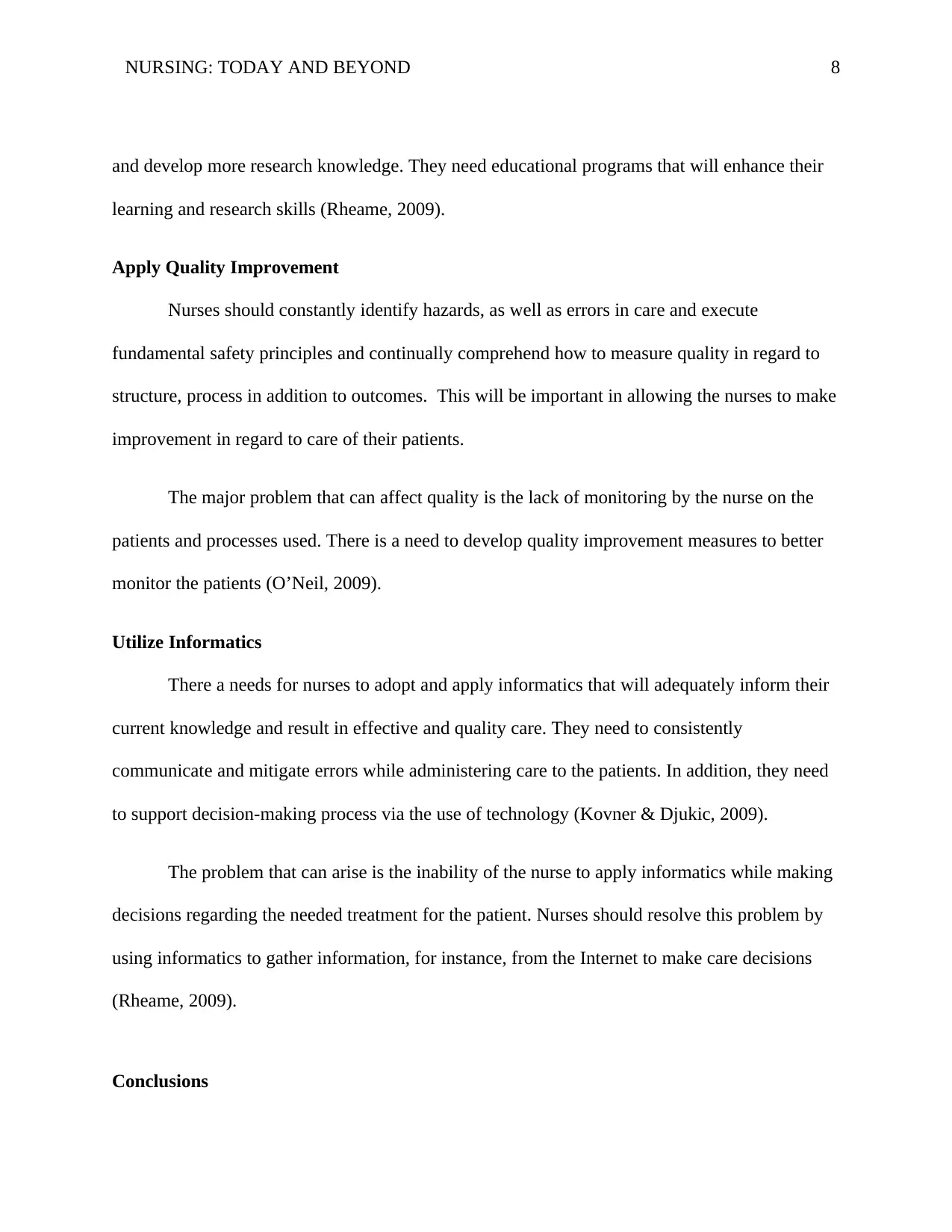
NURSING: TODAY AND BEYOND 8
and develop more research knowledge. They need educational programs that will enhance their
learning and research skills (Rheame, 2009).
Apply Quality Improvement
Nurses should constantly identify hazards, as well as errors in care and execute
fundamental safety principles and continually comprehend how to measure quality in regard to
structure, process in addition to outcomes. This will be important in allowing the nurses to make
improvement in regard to care of their patients.
The major problem that can affect quality is the lack of monitoring by the nurse on the
patients and processes used. There is a need to develop quality improvement measures to better
monitor the patients (O’Neil, 2009).
Utilize Informatics
There a needs for nurses to adopt and apply informatics that will adequately inform their
current knowledge and result in effective and quality care. They need to consistently
communicate and mitigate errors while administering care to the patients. In addition, they need
to support decision-making process via the use of technology (Kovner & Djukic, 2009).
The problem that can arise is the inability of the nurse to apply informatics while making
decisions regarding the needed treatment for the patient. Nurses should resolve this problem by
using informatics to gather information, for instance, from the Internet to make care decisions
(Rheame, 2009).
Conclusions
and develop more research knowledge. They need educational programs that will enhance their
learning and research skills (Rheame, 2009).
Apply Quality Improvement
Nurses should constantly identify hazards, as well as errors in care and execute
fundamental safety principles and continually comprehend how to measure quality in regard to
structure, process in addition to outcomes. This will be important in allowing the nurses to make
improvement in regard to care of their patients.
The major problem that can affect quality is the lack of monitoring by the nurse on the
patients and processes used. There is a need to develop quality improvement measures to better
monitor the patients (O’Neil, 2009).
Utilize Informatics
There a needs for nurses to adopt and apply informatics that will adequately inform their
current knowledge and result in effective and quality care. They need to consistently
communicate and mitigate errors while administering care to the patients. In addition, they need
to support decision-making process via the use of technology (Kovner & Djukic, 2009).
The problem that can arise is the inability of the nurse to apply informatics while making
decisions regarding the needed treatment for the patient. Nurses should resolve this problem by
using informatics to gather information, for instance, from the Internet to make care decisions
(Rheame, 2009).
Conclusions
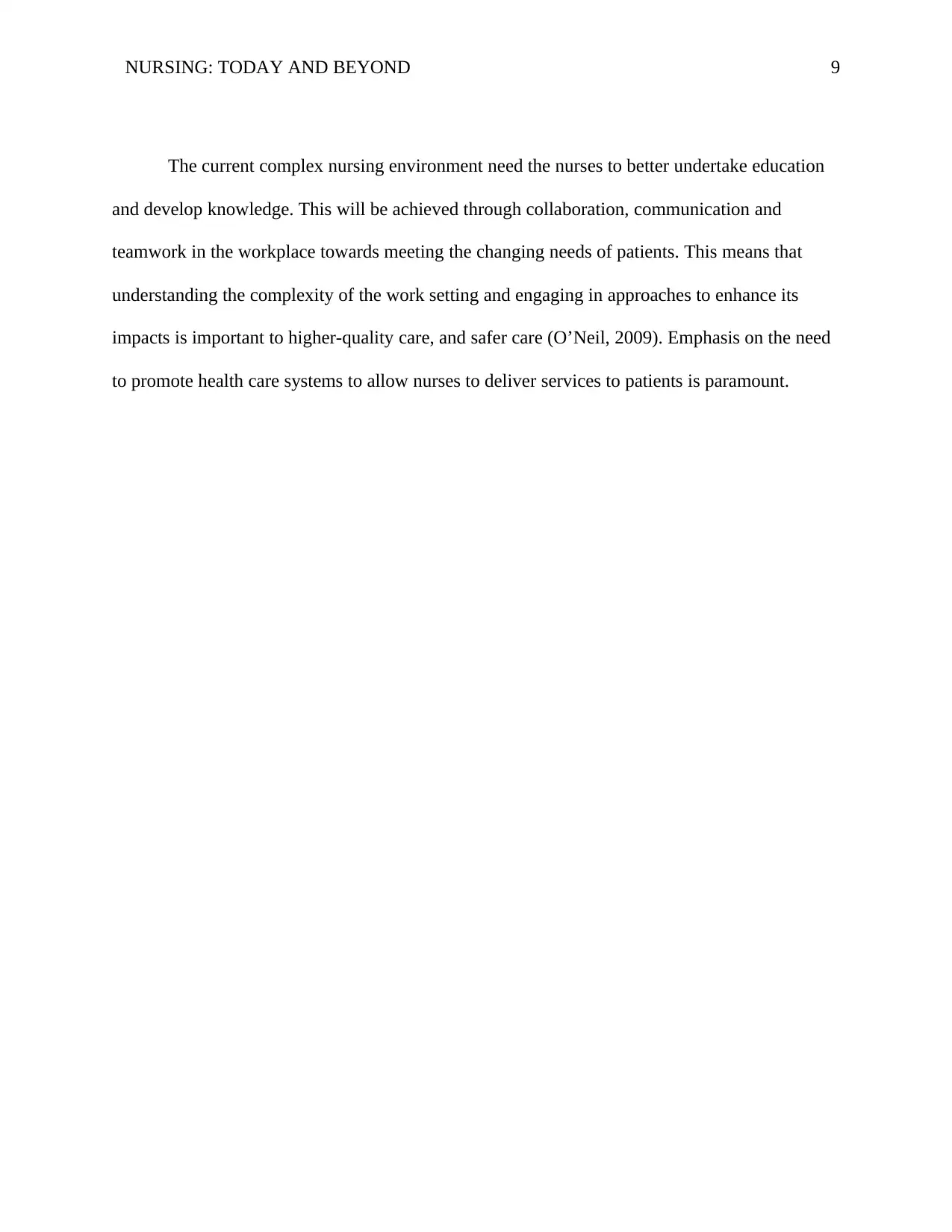
NURSING: TODAY AND BEYOND 9
The current complex nursing environment need the nurses to better undertake education
and develop knowledge. This will be achieved through collaboration, communication and
teamwork in the workplace towards meeting the changing needs of patients. This means that
understanding the complexity of the work setting and engaging in approaches to enhance its
impacts is important to higher-quality care, and safer care (O’Neil, 2009). Emphasis on the need
to promote health care systems to allow nurses to deliver services to patients is paramount.
The current complex nursing environment need the nurses to better undertake education
and develop knowledge. This will be achieved through collaboration, communication and
teamwork in the workplace towards meeting the changing needs of patients. This means that
understanding the complexity of the work setting and engaging in approaches to enhance its
impacts is important to higher-quality care, and safer care (O’Neil, 2009). Emphasis on the need
to promote health care systems to allow nurses to deliver services to patients is paramount.
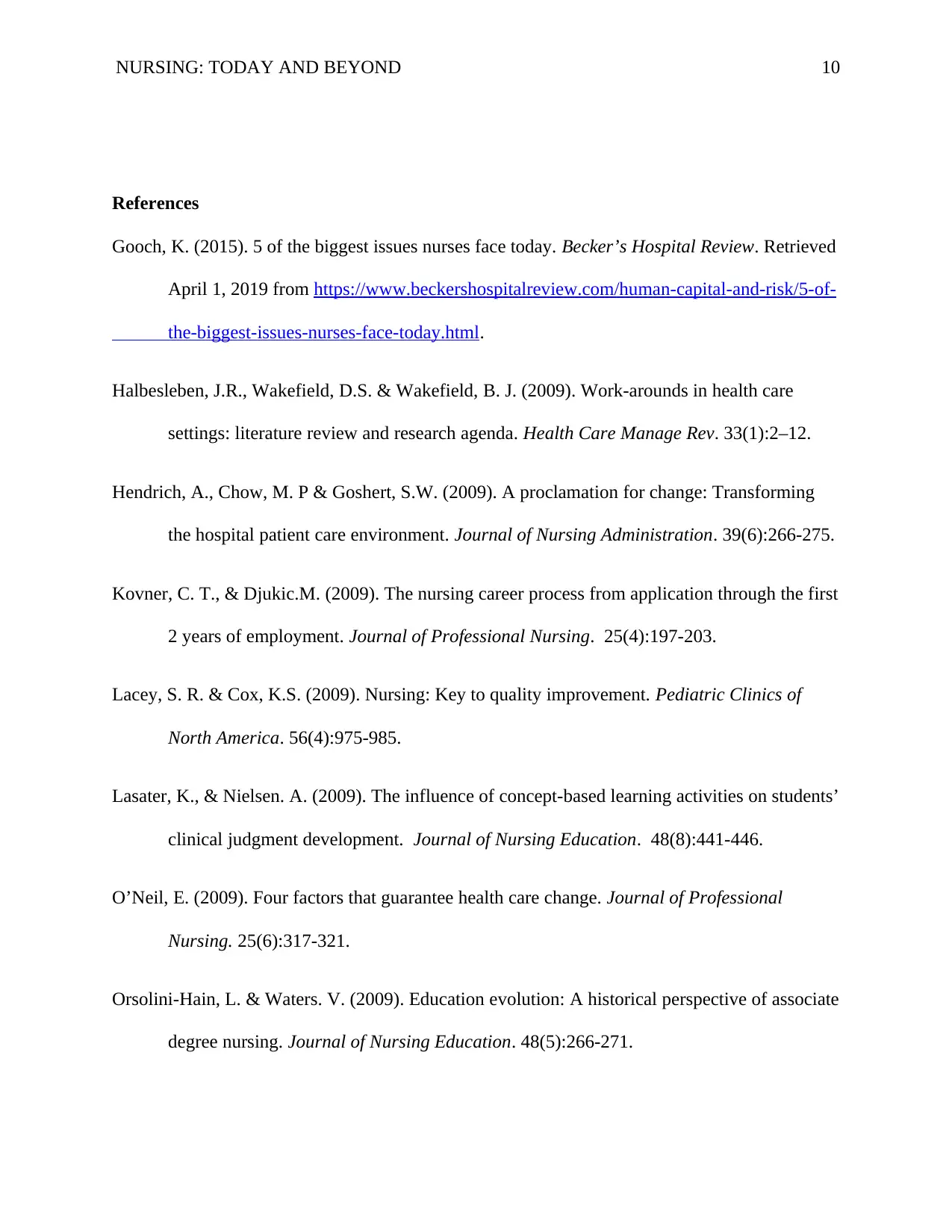
NURSING: TODAY AND BEYOND 10
References
Gooch, K. (2015). 5 of the biggest issues nurses face today. Becker’s Hospital Review. Retrieved
April 1, 2019 from https://www.beckershospitalreview.com/human-capital-and-risk/5-of-
the-biggest-issues-nurses-face-today.html.
Halbesleben, J.R., Wakefield, D.S. & Wakefield, B. J. (2009). Work-arounds in health care
settings: literature review and research agenda. Health Care Manage Rev. 33(1):2–12.
Hendrich, A., Chow, M. P & Goshert, S.W. (2009). A proclamation for change: Transforming
the hospital patient care environment. Journal of Nursing Administration. 39(6):266-275.
Kovner, C. T., & Djukic.M. (2009). The nursing career process from application through the first
2 years of employment. Journal of Professional Nursing. 25(4):197-203.
Lacey, S. R. & Cox, K.S. (2009). Nursing: Key to quality improvement. Pediatric Clinics of
North America. 56(4):975-985.
Lasater, K., & Nielsen. A. (2009). The influence of concept-based learning activities on students’
clinical judgment development. Journal of Nursing Education. 48(8):441-446.
O’Neil, E. (2009). Four factors that guarantee health care change. Journal of Professional
Nursing. 25(6):317-321.
Orsolini-Hain, L. & Waters. V. (2009). Education evolution: A historical perspective of associate
degree nursing. Journal of Nursing Education. 48(5):266-271.
References
Gooch, K. (2015). 5 of the biggest issues nurses face today. Becker’s Hospital Review. Retrieved
April 1, 2019 from https://www.beckershospitalreview.com/human-capital-and-risk/5-of-
the-biggest-issues-nurses-face-today.html.
Halbesleben, J.R., Wakefield, D.S. & Wakefield, B. J. (2009). Work-arounds in health care
settings: literature review and research agenda. Health Care Manage Rev. 33(1):2–12.
Hendrich, A., Chow, M. P & Goshert, S.W. (2009). A proclamation for change: Transforming
the hospital patient care environment. Journal of Nursing Administration. 39(6):266-275.
Kovner, C. T., & Djukic.M. (2009). The nursing career process from application through the first
2 years of employment. Journal of Professional Nursing. 25(4):197-203.
Lacey, S. R. & Cox, K.S. (2009). Nursing: Key to quality improvement. Pediatric Clinics of
North America. 56(4):975-985.
Lasater, K., & Nielsen. A. (2009). The influence of concept-based learning activities on students’
clinical judgment development. Journal of Nursing Education. 48(8):441-446.
O’Neil, E. (2009). Four factors that guarantee health care change. Journal of Professional
Nursing. 25(6):317-321.
Orsolini-Hain, L. & Waters. V. (2009). Education evolution: A historical perspective of associate
degree nursing. Journal of Nursing Education. 48(5):266-271.
Secure Best Marks with AI Grader
Need help grading? Try our AI Grader for instant feedback on your assignments.
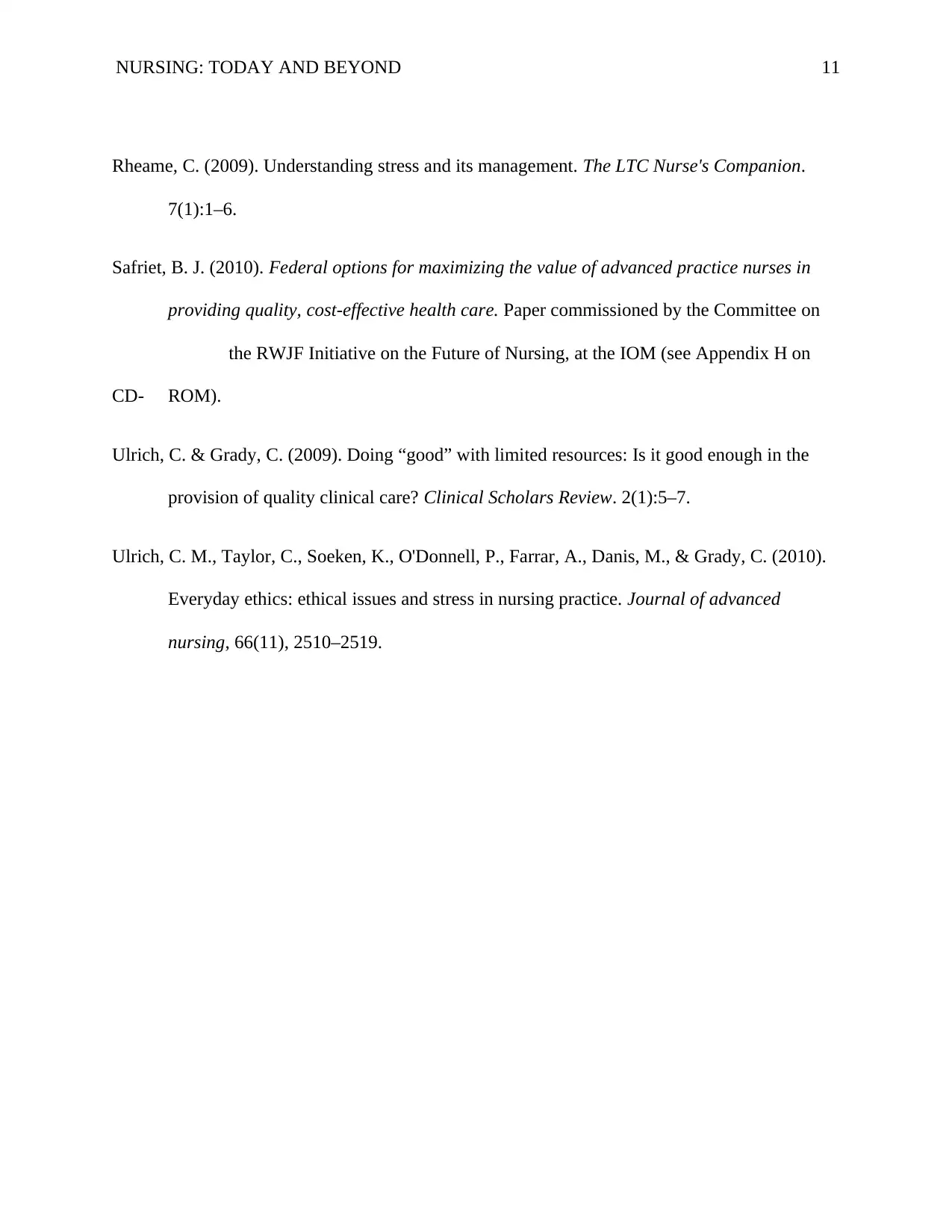
NURSING: TODAY AND BEYOND 11
Rheame, C. (2009). Understanding stress and its management. The LTC Nurse's Companion.
7(1):1–6.
Safriet, B. J. (2010). Federal options for maximizing the value of advanced practice nurses in
providing quality, cost-effective health care. Paper commissioned by the Committee on
the RWJF Initiative on the Future of Nursing, at the IOM (see Appendix H on
CD- ROM).
Ulrich, C. & Grady, C. (2009). Doing “good” with limited resources: Is it good enough in the
provision of quality clinical care? Clinical Scholars Review. 2(1):5–7.
Ulrich, C. M., Taylor, C., Soeken, K., O'Donnell, P., Farrar, A., Danis, M., & Grady, C. (2010).
Everyday ethics: ethical issues and stress in nursing practice. Journal of advanced
nursing, 66(11), 2510–2519.
Rheame, C. (2009). Understanding stress and its management. The LTC Nurse's Companion.
7(1):1–6.
Safriet, B. J. (2010). Federal options for maximizing the value of advanced practice nurses in
providing quality, cost-effective health care. Paper commissioned by the Committee on
the RWJF Initiative on the Future of Nursing, at the IOM (see Appendix H on
CD- ROM).
Ulrich, C. & Grady, C. (2009). Doing “good” with limited resources: Is it good enough in the
provision of quality clinical care? Clinical Scholars Review. 2(1):5–7.
Ulrich, C. M., Taylor, C., Soeken, K., O'Donnell, P., Farrar, A., Danis, M., & Grady, C. (2010).
Everyday ethics: ethical issues and stress in nursing practice. Journal of advanced
nursing, 66(11), 2510–2519.
1 out of 11
Related Documents
Your All-in-One AI-Powered Toolkit for Academic Success.
+13062052269
info@desklib.com
Available 24*7 on WhatsApp / Email
![[object Object]](/_next/static/media/star-bottom.7253800d.svg)
Unlock your academic potential
© 2024 | Zucol Services PVT LTD | All rights reserved.





